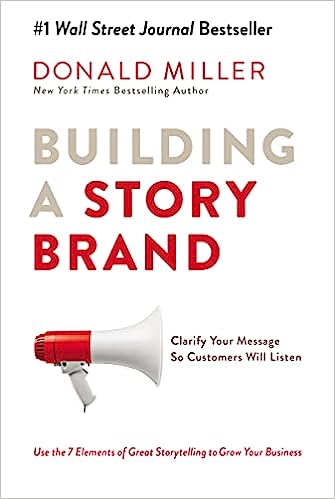Table of Contents
Are you struggling to grow your business? You have a stellar product or service, yet you’re not getting the traction you need for some reason. Despite having tried multiple marketing tactics, none of them seem to work. What if I told you there’s a simple tool that can help you powerfully connect with your audience? What if it was guaranteed to make your business stand out? It’s called storytelling in marketing. Today, I’ll show you how to use storytelling to create a compelling brand story that connects deeply with your customers.
As human beings, we’re wired to respond to stories. Stories captivate us, inspire us, and move us. That’s why storytelling content marketing has become such an essential part of modern business. By using stories to convey their brand message, companies can create a magnetic emotional connection with their audience, build trust, and inspire action. We’ll explore why storytelling in marketing is so imperative and how to use it to take your business to the next level.
So, how can you use storytelling to grow your business? That’s what we’ll cover in this article:
- I’ll explain the value of storytelling in branding and marketing.
- I’ll introduce you to the StoryBrand Framework, a powerful storytelling tool that can help you clarify your message, connect with your audience, and create a brand story that resonates.
- I’ll show you how to implement the StoryBrand Framework in your own business, step by step.
Nearly every business owner or marketer will find relevant insights in this article to help you harness the genius of storytelling in marketing.
The Value of Storytelling in Marketing & Branding
Storytelling has become a crucial aspect of modern marketing and branding. It is the art of crafting narratives that capture customers’ attention and convey a brand’s message compellingly. In our highly competitive market, customers are exposed to a myriad of marketing messages every day. Storytelling has emerged as a powerful tool to stand out from the crowd. By creating an emotional connection with their customers, brands can build trust, loyalty, and a subtle sense of community.

Building Deeper Connections with Storytelling
Effective storytelling content can help build deeper connections with customers by creating an emotional bond between the brand and the customer. Stories give you the power to evoke emotions, stimulate the imagination, and foster empathy. When a brand tells a story that resonates with a customer’s values and beliefs, it can create a sense of connection and a feeling of shared experiences. This connection can increase customer engagement, loyalty, and conversion rates.
Emotions and Trust: The Power of Storytelling

One of the key benefits of storytelling in marketing is that it helps to build trust. When a brand tells a story, it humanizes the brand and makes it relatable to customers. A well-crafted story can elicit emotions such as joy, empathy, or nostalgia, leading to a deeper emotional connection with the brand. By building this emotional connection and trust, customers are more likely to feel comfortable purchasing from the brand, even if the price is higher than a competitor’s.
Unique Brand Identity Through Storytelling
Every brand has a unique story to tell. Storytelling in branding can help a brand differentiate itself by conveying its values, vision, and mission compellingly. By crafting a unique narrative, a brand can create a distinct identity and stand out from the competition. This unique brand identity can help the brand to build a loyal customer base that aligns with the brand’s values and beliefs.
Benefits of Storytelling for Business Growth
Effective storytelling can lead to business growth by increasing brand awareness, customer engagement, and revenue. When a brand tells a compelling story that deeply resonates with customers, a powerful word-of-mouth effect is created. Customers are more likely to share a compelling story with their friends and family, which can lead to increased brand exposure and awareness. Additionally, storytelling can increase customer engagement, leading to higher conversion rates and increased revenue.
Building Strong Connections Through the Customer Journey
Compelling storytelling can help a brand to build strong connections with customers throughout the customer journey. By crafting stories tailored to different stages of the customer journey, a brand can create a cohesive narrative that guides the customer through the buying process. From the initial brand awareness stage to the post-purchase stage, storytelling and marketing can help reinforce the brand’s message and create a sense of community and customer loyalty.
In summary, storytelling in marketing is a powerful tool for modern marketing and branding. By building emotional connections with customers, fostering trust, creating a unique brand identity, and driving business growth, storytelling can help brands stand out in a crowded market and build a loyal customer base.
The StoryBrand Framework
The StoryBrand framework (also known as the SB7 Framework) is a proven marketing strategy that helps businesses of all sizes clarify their message, engage with their customers, and increase their revenue. Developed by author and marketing expert Donald Miller, the StoryBrand framework is based on the concept that customers don’t buy products or services; they buy solutions to problems. By using a clear and concise message that positions the customer as the hero of the story, businesses can create a powerful brand narrative that resonates with their target audience and drives results.
The 7 Key Elements of the StoryBrand Framework
In the previous section, I introduced the StoryBrand Framework and its seven key elements. Let’s dive deeper into these elements to understand how they work together to create a powerful marketing message.
Character: Positioning the Customer As the Hero
The first element of the StoryBrand Framework is positioning the customer as the story’s hero. Every great story has a hero on a quest to overcome obstacles and achieve their goals. In marketing, it’s essential to position the customer as the hero, not the business. This means understanding the customer’s needs, desires, and pain points, and crafting a message that speaks directly to them.

Problem: Identifying the Customer’s Problem
The second element of the StoryBrand Framework is identifying the customer’s problem. Every hero is on a mission to solve a problem, and your marketing message should be focused on solving that problem. This means understanding your customer’s pain points and challenges, and presenting your product or service as the solution to their problem.
Guide: Positioning the Business As the Guide
The third element of the StoryBrand Framework is positioning the business as the guide. Every hero needs a guide to help them navigate their journey and overcome obstacles. In marketing, it’s crucial to position your business as the guide who can help the hero (customer) achieve their goals. This means focusing on the benefits and value your company can provide the customer.
Plan: Offering a Clear Plan for Solving the Customer’s Problem
The fourth element of the StoryBrand Framework is offering a clear plan for solving the customer’s problem. Every hero needs a plan to achieve their goals, and your marketing message should provide a clear plan for how your product or service can solve the customer’s problem. This means outlining the steps and processes the customer needs to take to achieve success.
Call to Action: Encouraging Customers to Take Action
The fifth element of the StoryBrand Framework is encouraging customers to take action. Every hero needs to take action to achieve their goals, and your marketing message should include a clear call to action. This means telling the customer exactly what they need to do next, whether buying your product, signing up for your service, or contacting you for more information.
Failure: Avoiding Failure and Achieving Success

The sixth element of the StoryBrand Framework is avoiding failure and achieving success. Every hero faces obstacles and challenges on their journey, and your marketing message should position your product or service as the key to avoiding failure and achieving success. This means highlighting the consequences of not using your product or service and demonstrating how your product or service can help the customer overcome their challenges.
Success: Painting the Vision for Success
The seventh and final element of the StoryBrand Framework is painting the vision for success. Every hero needs to know what success looks like, and your marketing message should paint a clear picture of the benefits and outcomes of using your product or service. This means highlighting the transformation the customer will experience by using your product or service and showing them how it will help them achieve their goals and dreams.
Creating A Brand Story With The StoryBrand Framework
You must inject storytelling into your marketing, if you’re going to reap the benefits! Creating a brand story using the StoryBrand Framework is a powerful way to connect with customers, build brand loyalty, and drive business growth. By following a proven formula, businesses can create a clear and compelling story that resonates with their target audience.
Step-by-Step Guide to Creating a Brand Story
To create a brand story using the StoryBrand Framework:
- Start by identifying your target audience’s pain points and position them as the hero of your story.
- Position your business as the guide who can help them overcome challenges by providing a clear plan.
- Encourage your customers to take action by providing a clear call to action and painting a vision of success.

Identifying the Customer’s Problem and Positioning Them As the Hero
To create a compelling brand story, it is crucial to identify the problem that your target audience is facing. Position your customers as the hero of your story, struggling to overcome their challenges. By positioning the customer as the hero, you are creating an emotional connection with your target audience and making them more invested in your brand’s success.
Positioning the Business As the Guide and Providing a Clear Plan
As the guide in your brand story, your business should provide a clear plan for your customers to overcome their challenges. Your plan should be easy to understand and implement and provide clear steps for your customers to follow. By positioning your business as the guide, you build trust with your target audience and establish yourself as an authority in your industry.
Encouraging Customers to Take Action and Implement the Plan
To make your brand story effective, you must encourage your customers to act and implement your plan. Your call to action should be clear and compelling, enabling your customers to take the next step. By providing a clear vision of success, you can motivate your customers to take action and achieve their goals.
Common Mistakes to Avoid
When using storytelling in marketing and creating a brand story using the StoryBrand Framework, it is essential to avoid common mistakes. These include focusing too much on your business rather than the customer, using industry jargon your customers may not understand, and making your brand story too complicated. Keep your brand story simple and focused on the needs of your target audience.
Keeping the Brand Story Simple and Authentic
To create an effective brand story, keep it simple and authentic. Your story should be easy to understand and resonate with your target audience. Use clear and concise language, and avoid industry jargon your customers may not understand. Keeping your brand story authentic builds trust with your target audience and establishes a long-lasting connection with them.

Incorporating Storytelling into Different Marketing Channels
Once you’ve created a compelling brand story, it’s essential to incorporate storytelling in multiple marketing channels to maximize its impact. You can use your brand story in your website copy, product descriptions, social media posts, video marketing, email marketing, and more. The key is to ensure that your brand story is consistent across all channels and resonates with your target audience.
Telling Brand Stories on Social Media
Social media is an excellent platform for telling your brand story and connecting with your audience. It’s best to use various social media platforms to tell your story. The key is to use engaging visuals and videos that capture your audience’s attention and communicate your brand story effectively. Make sure to include a call-to-action in your posts to encourage your audience to take the desired action.
Using Email Marketing to Drive Conversions
Email marketing is another effective way to tell your brand story and drive conversions. You can use email marketing to send personalized messages to your audience and educate them about your product or service. When crafting your email messages, focus on your customer’s needs and how your product or service can solve their problems. Include a clear call to action in your emails to encourage subscribers to take action.
Success Stories: Brands that Mastered Storytelling
The power of storytelling is evident in the success of many iconic brands. This section will examine how Tesla, Apple, Red Bull, GoPro, Old Spice, Lululemon, Peloton, Lush, and TOMS have used the StoryBrand framework to create compelling brand stories that resonate with their audience.

Tesla: Disrupting the Automotive Industry with a Unique Story
Tesla’s brand story is centered around its mission to accelerate the world to transition to sustainable energy. The company positions itself as a visionary force in the automotive industry, aiming to create a cleaner, more sustainable future. Elon Musk has been the driving force behind Tesla’s narrative. Musk hasn’t exactly made a secret of his genuine desire to positively change the world. By framing Tesla’s story around a higher purpose, the brand has created a loyal following of customers who believe in its mission.
For those looking to create a brand story like Tesla’s, it’s essential to identify a higher purpose that your business can work towards. This could be something as simple as making people’s lives easier or something more ambitious, like changing the world. By positioning your business as a force for good, you will create a positive narrative that resonates with your audience, inspiring them to take action.
Apple: The Power of Simplicity in Storytelling
Apple’s brand story is all about simplicity. The company positions itself as a champion of clean design and ease of use. Apple’s products are known for their intuitive interfaces and minimalist aesthetics. This simplicity also extends to the company’s branding, with the iconic Apple logo and minimalist product packaging. Apple has created a strong, consistent narrative that sets it apart from its competitors by focusing on simplicity in its brand story.
To create a brand story like Apple’s, focus on simplicity in all aspects of your business. Streamline your branding, product design, and marketing messaging to create a consistent narrative that emphasizes ease of use and simplicity. Doing so allows you to create a brand story that sets you apart from your competitors and resonates with your audience.
Red Bull: Going Beyond Energy Drinks with Extreme Storytelling
Red Bull’s brand story is all about extreme sports and adventure. The company has used its brand to position itself as a lifestyle brand, rather than just an energy drink. Red Bull sponsors extreme sports events and athletes, and its marketing often features stunning visuals of people doing incredible stunts, such as flying wingsuits over the Pyramids of Giza. By positioning itself as a lifestyle brand, Red Bull has created a strong emotional connection with its audience beyond just selling energy drinks.
Red Bull’s homepage barely features any products at all. Everything hinges on the stories of their customers, and that is placed front and center. Their focus is on the identity of their consumers. They sell more than energy drinks; they sell a lifestyle of energy.
For those looking to create a brand story like Red Bull’s, thinking beyond your product or service is important. Look for ways to position your brand as a lifestyle choice, rather than just a commodity. By creating a narrative that goes beyond your product, you can forge a deeper emotional connection with your audience, setting you apart from your competitors.
GoPro: Empowering Customers to Create Their Own Story
GoPro’s brand story is centered around empowering customers to create their own stories. The company’s cameras are designed to capture action-packed footage of people doing incredible things. GoPro’s marketing often features user-generated content, showing real people using the product in unique and exciting ways. By positioning itself as a brand that empowers its customers, GoPro has created a loyal following of customers who feel a strong emotional connection to the brand.
To create a brand story like GoPro’s, focus on empowering your customers. Look for ways to make your customers the hero of your brand story, and create marketing that features user-generated content. Doing so will create a narrative that resonates with your audience on a personal level and inspires them to become loyal customers too.
Old Spice: Revitalizing a Classic Brand with Memorable Storytelling
Old Spice, a classic men’s grooming brand, underwent a major rebranding in 2010 with their “Smell Like a Man, Man” campaign. The campaign was a huge success, featuring memorable characters and humorous storytelling that repositioned the brand as edgy and cool. The company continued to innovate with their marketing campaigns, including interactive YouTube videos and personalized social media responses. As a result, Old Spice saw a significant increase in sales and brand loyalty.
Later, in 2012, they ran an ad campaign called “There’s A Man In There,” which featured a cutaway of a guy in an elevator that revealed a Rambo-like interior being, complete with a python instead of his scarf and a combat helmet full of cereal. This identifies with the innate, regal man locked inside, despite the realities of a sedentary lifestyle, which is externally visible. Both campaigns exhibited utter marketing genius.
Readers can learn from Old Spice’s success by taking risks and being bold with their storytelling. By breaking away from traditional advertising techniques and creating something truly unique and memorable, businesses can generate buzz and establish themselves as leaders in their industry.
Lululemon: Inspiring Customers to Live Their Best Story
Lululemon, a yoga and athletic apparel brand, has built their brand story around the concept of empowering individuals to live their best life. Through their marketing campaigns, Lululemon emphasizes the importance of mindfulness, community, and self-improvement. The brand has also created a solid social media presence, regularly featuring inspiring stories from their customers and ambassadors.
Businesses can take inspiration from Lululemon’s emphasis on community and personal growth. By positioning their brand as a catalyst for positive change and encouraging their customers to share their stories, businesses can create a motivated and engaged community to support their brand over the long term.
Peloton: Building a Community Around the Story of Fitness
Peloton, an exercise equipment and digital fitness brand, has revolutionized the at-home workout experience by creating a strong sense of community around their products. Through their digital platform, Peloton connects users with live and on-demand workouts and a supportive community of other users. The brand has also built a strong social media presence, regularly sharing inspiring stories from their users and encouraging them to connect with each other.
Businesses can learn from Peloton’s success by building a strong community around their brand. By creating a platform that allows users to connect and share their experiences, businesses can foster a sense of loyalty and create a positive reputation for their brand.
Lush: Crafting a Story of Sustainability and Ethical Beauty
Lush, a handmade cosmetics brand, has built their brand story around the concepts of sustainability, ethical sourcing, and environmental responsibility. The company uses natural and organic ingredients, avoids animal testing, and sources materials from ethical and sustainable suppliers. Through their marketing campaigns and social media presence, Lush has positioned themselves as a brand that cares about both the environment and the well-being of their customers.
Businesses can learn from Lush’s commitment to sustainability and ethical sourcing. By prioritizing these values in their products and marketing campaigns, companies can attract customers looking for socially responsible and environmentally friendly options.
TOMS: Putting Social Responsibility at the Heart of the Story
TOMS, a footwear and accessories brand, has built their brand story around social responsibility. TOMS donates a pair to a child in need for every pair of shoes sold. The company also supports a variety of social and environmental causes through their TOMS One for One program. Through their marketing campaigns and social media presence, TOMS has positioned themselves as a brand that cares about positively impacting the world.
Businesses can learn from TOMS’ commitment to social responsibility by incorporating giving back into their brand story. By supporting causes that align with their values and positively impacting their communities, businesses can build a strong reputation and attract customers who share their commitment to social responsibility.
Now It’s Up To You
As we come to the end of this article, I hope you now understand the power of storytelling in creating an unforgettable brand identity. The StoryBrand Framework offers a step-by-step guide to help you create a brand story that resonates with your customers and positions your business as the guide to help them succeed.
To summarize, we first discussed a brand story and why it is essential for creating a compelling brand identity. I then introduced the StoryBrand Framework and walked you through the steps involved in creating a brand story, such as positioning the customer as the hero, identifying their problem, positioning your business as the guide, offering a clear plan, and encouraging customers to take action.
I also highlighted the success stories of some of the most well-known brands, including Tesla, Apple, Red Bull, GoPro, Old Spice, Lululemon, Peloton, Lush, and TOMS, and how they used storytelling to position themselves and engage their customers.
In conclusion, storytelling in marketing is a powerful tool to help you build a loyal customer base, increase brand awareness, and drive conversions. Creating a brand story that resonates with your customers allows you to differentiate yourself from your competitors and establish a unique brand identity. My final recommendation is to keep your brand story simple, authentic, and consistent across all your marketing channels. I wish you the best of luck in creating a compelling brand story that captures the hearts and minds of your customers.









